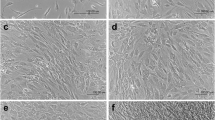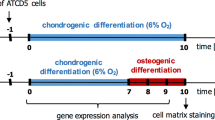Abstract
We have followed the synthesis and secretion of urokinase-type plasminogen activator (u-PA) and its inhibitor, PAI-1, and matrix metalloproteinases (MMPs) and tissue inhibitor of metalloproteinases (TIMP-1) during differentiation of a human osteoblastic cell line, HOS TE85, and the effect of TNF-α on this process. Our results show that the ratio of u-PA/PAI-1 associated with the cell-matrix components increases during differentiation of these cells over a 14-day period. Although TNF-α suppresses the induced increase in steady-state mRNA levels of u-PA and PAI-1 during maturation of extracellular matrix (ECM), the u-PA/PAI-1 ratio is altered in such a way that PA activity associated with the ECM is higher than control cells. The expression of MMP-1 is low and remains essentially invariant over a culture period of 14 days. TNF-α enhances MMP-1 transcription nearly 12-fold initially, after which mRNA levels drop off but remain significantly higher than the controls. Activities and steady-state mRNA levels of MMP-2 and MMP-9 increase nearly 15-fold during maturation of the ECM, but the level of TIMP-1 mRNA is not appreciably altered. The presence of TNF-α suppresses maturation-induced transcription of MMP-2, enhances TIMP-1 transcription, but has little effect on MMP-9 mRNA levels. The data show that chronic exposure to TNF-α alters the balance between u-PA/PAI- 1 and MMPs/TIMP-1, which favors higher activity of proteinases. Accordingly, the presence of TNF-α in chronic inflammatory episodes would be expected to alter bone remodeling by inhibiting maturation of ECM and formation of bone.
Similar content being viewed by others
References
Peck, W.A., S.J. Birge, andS.A. Fedak. 1964. Bone cells: biochemical and biological studies after enzymatic isolation.Science 146:1476–1477.
Binderman, W.A., D. Duskin, A. Harell, E. Katzir, andL. Sachs. 1974. Formation of bone tissue in culture from isolated bone cells.J. Cell Biol. 61:426–439.
Nefussi, J.-R., M.L. Boy-Lefevre, H. Boulekbache, andN. Forest. 1985. Mineralization in vitro of matrix formed by osteoblasts isolated by collagenase digestion.Differentiation 29:160–168.
Bellows, C.G., J.E. Aubin, J.N.M. Heersche, andM.E. Antosz. 1986. Mineralized bone nodules formed in vitro from enzymatically released rat calvarial cell populations.Calcif. Tissue Int. 38:143–154.
Simmons, D. J., G.N. Kent, R.L. Jilka, D.M. Scott, M. Fallon, andD.V. Cohn. 1982. Formation of bone by isolated, cultured osteoblasts in millipore diffusion chambers.Calcif. Tissue Int. 34:291–294.
Gerstenfeld, L.C., S.D. Chipman, C.M. Kelley, K.J. Hodgens, D.D. Lee, andW.J. Landis. 1988. Collagen expression, ultrastructural assembly, and mineralization in cultures of chicken embryo osteoblasts.J. Cell Biol. 106:979–989.
Whitson, S.W., M.A. Whitson, D.E. Bowers, Jr., andM.C. Falk. 1992. Factors influencing synthesis and mineralization of bone matrix from fetal bovine bone cells grown in vitro.J. Bone Min. Res. 7:727–741.
Robey, R.G., andJ.D. Termine. 1985. Human bone cells in vitro.Calcif. Tissue Int. 37:453–460.
Partridge, N.C., D. Alcorn, V.P. Michelangeli, B.E. Kemp, G.B. Ryan, andT.J. Martin. 1981. Functional properties of hormonally responsive cultured normal and malignant rat osteoblastic cells.Endocrinology 108:213–219.
Kodama, H., Y. Amagai, H. Sudo, S. Kasai, andS. Yamamoto. 1981. Establishment of a clonal osteogenic cell line from newborn mouse calvaria.Jpn. J. Oral. Biol. 23:899–901.
Sudo, H., H. Kodama, Y. Amagai, S. Yamamoto, andS. Kasai. 1983. In vitro differentiation and calcification in a new clonal osteogenic cell line derived from newborn mouse calvaria.J. Cell Biol. 96:191–198.
Walters, M.R., D.M. Rosen, A.W. Norman, andR.A. Luben. 1982. 1,25-Dihydroxyvitamin D receptors in an established bone cell line.J. Biol. Chem. 257:7481–7484.
Canalis, E. 1985. Effect of growth factors on bone cell replication and differentiation.Clin. Orthop. 193:246–263.
Canalis, E., T. McCarthy, andM. Centrella. 1988. Growth factors and the regulation of bone remodelling.J. Clin. Invest. 81:277–281.
Noda, M., andG.A. Rodan. 1987. Typeβ transforming growth factor (TGFβ) regulation of alkaline phosphatase expression and other phenotype-related mRNAs in osteoblastic rat osteosarcoma cells.J. Cell. Physiol. 133:426–437.
Sato, K., Y. Fujii, K. Kasono, M. Ozawa, H. Imamura, Y. Kanaji, H. Kurosawa, T. Tsushima, andK. Shizume. 1989. Parathyroid hormone-related protein and interleukin-1β synergistically stimulate bone resorption in vitro and increase the serum calcium concentration of mice in vivo.Endocrinology 124:2172–2178.
Spencer, E.M., C.C. Liu, E.C. Si, andG.A. Howard. 1991. In vivo actions of insulin-like growth factor I (IGF-I) on bone formation and resorption in rats.Bone 12:21–26.
Hauschka, P.V. Growth factor effects in bone.In The Osteoblast and the Osteocyte, Bone Vol. 1. B.K.Hall, editor. The Telford Press, Caldwell, New Jersey 103–170.
Goldhaber, P., L. Rabajija, W.R. Beyer, andA. Kornhauser. 1973. Bone resorption in tissue culture and its relevance to periodontal disease.J. Am. Dent. Assoc. 87:1027–1033.
El Attar, T.M.A., andH.S. Lin. 1983. Relative conversion of arachidonic acid through lipoxygenase and cyclooxygenase pathways by homogenates of diseased periodontal tissues.J. Oral Pathol. 12:7–14.
Decker, J.L. 1984. Rheumatoid arthritis: Evolving concepts of pathogenesis and treatment.Ann Intern. Med. 101:810–824.
Meikle, M.D., J.K. Heath, andJ.J. Reynolds. 1986. Advances in understanding cell interactions in tissue resorption. Relevance to the pathogenesis of periodontal disease and a new hypothesis.J. Oral Pathol. 15:239–250.
Bertolini, D.R., G.E. Nedwin, T.S. Brinoham, D.D. Smith, andG.R. Mundy. 1986. Stimulation of bone resorption and inhibition of bone formation in vitro by human tumor necrosis factor.Nature 319:516–518.
Vaes, G. 1988. Cellular biology and bichemical mechanisms of bone resorption.Clin Orthop. Rel. Res. 231:239–272.
Stashenko, P., M.S. Obernesser, andF.E. Dewhirst. 1989. Effects of immune cytokines on bone.Immunol. Invest. 145:239–249.
Le, L., andJ. Vilcek. 1987. Tumor necrosis factor and Interleukin-1: Cytokines with multiple overlapping biological activities.Lab. Invest. 56:234–248.
Rosenblum, M.G., andN.J. Donato. 1989. Tumor necrosis factorα: A multifaceted peptide hormone.Crit. Rev. Immunol. 9:21–44.
Canalis, E. 1987. Effects of tumor necrosis factor on bone formation in vitro.Endocrinology 121:1596–1604.
Stashenko, P., F.E., Dewhirst, W.J. Peros, R.L. Kent, andJ.M. Ago. 1987. Synergistic interactions between interleukin 1, tumor necrosis factor, and lymphotoxin in bone resorption.J. Immunol. 138:1464–1468.
Thomson, B.M., G.R. Mundy, andT.J. Chambers. 1987. Tumor necrosis factorα andβ induce osteoblastic cells to stimulate osteoclastic bone resorption.J. Immunol. 138:775–779.
Panagakos, F.S., andS. Kumar. 1992. TNF modulation of bone formation and bone resorption in vitro.J. Dent. Res. 71:149.
Panagakos, F.S., L. Hinojosa, andS. Kumar. 1993. Matrix formation and mineralization by osteoblasts: Modulation by TNF-alpha.J. Dent. Res. 72:289.
Panagakos, F.S., L. Hinojosa, andS. Kumar. 1994. Formation and mineralization of extracellular matrix secreted by an immortal human osteoblastic cell line: Modulation by tumor necrosis factor-α.Inflammation 18:267–284.
Panagakos, F.S., andS. Kumar. 1994. Modulation of proteases and their inhibitors in immortal human osteoblast-like cells by tumor necrosis factor-alpha in vitro.Inflammation 18:243–265.
Jones, P.A., J.S. Rhim, H. Issacs, andR.M. McAlister. 1975. Relationship between tumoigenicity, growth, in agar, and fibrinolytic activity in a line of human osteosarcoma cells.Int. J. Cancer 16:616–621.
Lowry, O.H., N.J. Rosebrough, A.L. Farr, andR.J. Randall. 1951. Protein measurement with the Folin phenol reagent.J. Biol. Chem. 193:265–274.
Laemmli, U.K. 1970. Cleavage of structural proteins during the assembly of the head of bacteriophage T4.Nature 227:680–685.
Chomczynski, P., andN. Sacchi. 1989. Single-step method of RNA isolation by guanidinium thiocyanate-phenol-chloroform extraction.Anal. Biochem. 163:156–162.
Stein, G.S., J.B. Lian, andT.A. Owen. 1990. Relationship of cell growth to the regulation of tissue-specific gene expression during osteoblast differentiation.FASEB J. 4:3111–3123.
Stein, G.S., J.B. Lian, L. Gerstenfeld, V. Shaloub, M. Aronow, T. Owen, andE. Markose. 1989. The onset and progression of osteoblast differentiation is functionally related to cell proliferation.Connect. Tissue Res. 20:3–13.
Carrington, J.L., A.B. Roberts, K.C. Flanders, N.S. Roche, andA.H. Reddi. 1988. Accumulation, localization, and compartmentation of transforming growth factor-β during endochondral bone development.J. Cell Biol. 107:1969–1975.
Glimcher, M.J. 1989. Mechanism of calcification in bone: role of collagen fibrils and collagen phosphoprotein complexes.Anat. Rec. 224:139–153.
Lian, J.B., M.C. Coutts, andE. Canalis. 1985. Studies of hormonal regulation of osteocalcin synthesis in cultured fetal rat calvaria.J. Biol. Chem. 260:8706–8710.
Heingard, D., andA. Oldberg. 1989. Structure and biology of cartilage and bone matrix noncollagenous macromolecules.FASEB J. 3:2042–2051.
Johansen, J.S., M.K. Williamson, J.S. Rice, andP.A. Price. 1992. Identification of proteins secreted by human osteoblastic cells in culture.J. Bone. Min. Res. 7:501–512.
Hamilton, J.A., S.R. Lingelbach, N.C. Partridge, andT.J. Martin. 1985. Regulation of plasminogen activator production by bone resorbing hormones in normal and malignant osteoblasts.Endocrinology 116:2186–2191.
Partridge, N.C., J.J. Jeffrey, L.S. Ehlich, S.L. Teitelbaum, C. Fliszar, H.C. Welgus, andA.J. Kahn. 1987. Hormonal regulation of the production of collagenease and a collagenase inhibitor activity by rat osteogenic sarcoma cells.Endocrinology 120:1956–1961.
Hill, P.A., J.J. Reynolds, andM.C. Meikle. 1993. Inhibition of stimulated bone resorption in vitro by TIMP-1 and TIMP-2.Biochim. Biophys. Ada 1177:71–74.
Heath, J.K., S.J. Atkinson, M.C. Meikle, andJ.J. Reynolds. 1984. Mouse osteoblasts synthesize collagenase in response to bone resorbing agents.Biochim. Biophys. Ada 802:151–154.
Sakamoto, M., andS. Sakamoto. 1984. Immunocytochemical localization of collagenase in isolated mouse bone cells.Biomed. Res. 5:29–36.
Delaisse, J-M., Y. Eechhout, C. Sear, A. Galloway, K. McCullagh, andG. Vaes. 1985. A new synthetic inhibitor of mammalian collagenase inhibits bone resorption in culture.Biochem. Biophys. Res. Commun. 133:483–490.
Eeckhout, Y., J.-M. Delaisse, andG. Vaes. 1986. Direct extraction and assay of bone tissue collagenase and its relation to parathyroid-hormone-induced bone resorption.Biochem. J. 239:793–796.
Everts, V., J.-M. Delaisse, W. Korper, A. Niehof, G. Vaes, andW. Beertsen. 1992. Degradation of collagen in the bone-resorbing compartment underlying the osteoclast involves both cysteine-proteinases and matrix metalloproteinases.J. Cell. Physiol. 150:221–231.
Brown, P.D., D.E. Kleiner, E.J. Unsworth, andW.G. Stetler-Stevenson. 1993. Cellular activation of the 72 kDa type IV procollagenase-TIMP-2 complex.Kidney Int. 43:163–170.
Author information
Authors and Affiliations
Rights and permissions
About this article
Cite this article
Panagakos, F.S., Kumar, S. Differentiation of human osteoblastic cells in culture. Inflammation 19, 423–443 (1995). https://doi.org/10.1007/BF01534577
Issue Date:
DOI: https://doi.org/10.1007/BF01534577




